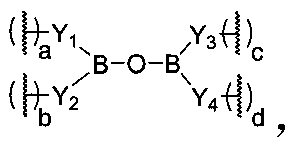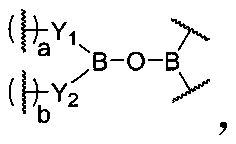Combined hybrid dynamic polymer and application thereof
A polymer and dynamic technology, applied in the field of smart materials, can solve the problems of limited dynamic effect and dynamic control ability, difficulty in synergistic orthogonal comprehensive performance, etc.
- Summary
- Abstract
- Description
- Claims
- Application Information
AI Technical Summary
Problems solved by technology
Method used
Image
Examples
preparation example Construction
[0578] In the preparation process of dynamic polymer foam materials, three methods of mechanical foaming, physical foaming and chemical foaming are mainly used to foam dynamic polymers.
[0579] Among them, the mechanical foaming method is to introduce a large amount of air or other gases into the emulsion, suspension or solution of the polymer with the help of strong stirring during the preparation of the dynamic polymer to make it a uniform foam, and then through physical Or chemical changes make it shape and become a foam material. In order to shorten the molding cycle, air can be introduced and emulsifiers or surfactants can be added.
[0580] Wherein, the physical foaming method is to use physical principles to realize the foaming of the polymer during the preparation of the dynamic polymer, which includes but not limited to the following methods: (1) inert gas foaming method, that is, after adding Press the inert gas into the molten polymer or pasty material under press...
Embodiment 1
[0603] Using dimethylformamide (DMF) as a solvent, controlling the molar ratio of 4-chloro-1-butene to sodium diselenide to be 2:1, reacting at 22°C for 24h under nitrogen protection conditions to obtain diselenium bond-containing Diene compound (a). Using 5-hexenylboronic acid and 3-(allyloxy)-1,2-propanediol as raw materials and triethylamine as a catalyst, the diene compound (b) is prepared through condensation reaction at 80°C. React 4-(4-iodo-2,3,5,6-tetrafluorophenoxy)butyl-1-ol with 4-pentenoyl chloride under the catalysis of triethylamine to obtain Alkene-containing compound (c). Using equimolar amounts of ethyl acrylate-2-isocyanate and hydroxyethyl acrylate as raw materials, using triethylamine as a catalyst, react in dichloromethane solvent to prepare diolefins containing carbamate groups in the chain Compound (d).
[0604]
[0605] Using Pt(dvs)-xylene solution as a catalyst, 1 molar equivalent of dimethyl-terminated hydrogen silicone oil (molecular weight is...
Embodiment 2
[0608] Using vinyl boronic acid and hydrogen-terminated silicone oil with a viscosity of about 3,000mPa·s as raw materials, boric acid-terminated silicone oil was prepared by hydrosilylation under the catalysis of platinum olefin complex Pt(dvs).
[0609] The amino-terminated silicone oil with a viscosity of about 2,000 mPa·s is used as a raw material, and reacted in the presence of an equimolar equivalent catalyst, triethyl orthoacetate, to obtain amidine-terminated silicone oil.
[0610] In a dry and clean three-necked flask, add 120ml of anhydrous toluene solvent successively, add 0.02mol of boric acid-terminated silicone oil, 0.02mol of pentaerythritol, 0.02mol of amidine-terminated silicone oil, 0.02mol of 3-[(2-carboxyethyl-di Methyl-silyl)oxy-dimethyl-silyl]propionic acid, add appropriate amount of triethylamine and tetramethylammonium hydroxide, continue to react at 80°C for 5h, and obtain light yellow transparent viscous sample , which can be applied as a self-healing...
PUM
| Property | Measurement | Unit |
|---|---|---|
| Apparent viscosity | aaaaa | aaaaa |
| Viscosity | aaaaa | aaaaa |
| Viscosity | aaaaa | aaaaa |
Abstract
Description
Claims
Application Information
 Login to View More
Login to View More - R&D
- Intellectual Property
- Life Sciences
- Materials
- Tech Scout
- Unparalleled Data Quality
- Higher Quality Content
- 60% Fewer Hallucinations
Browse by: Latest US Patents, China's latest patents, Technical Efficacy Thesaurus, Application Domain, Technology Topic, Popular Technical Reports.
© 2025 PatSnap. All rights reserved.Legal|Privacy policy|Modern Slavery Act Transparency Statement|Sitemap|About US| Contact US: help@patsnap.com



